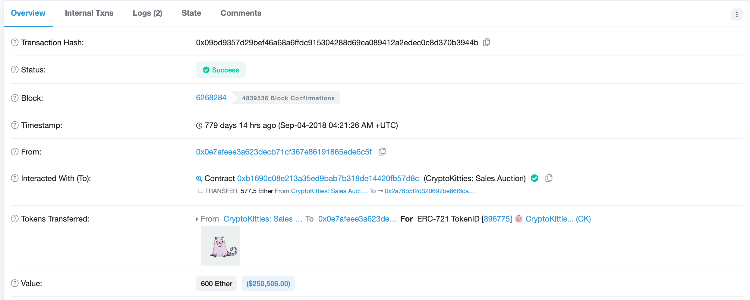- Ethereum blockchain is the home for many NFT projects
- The rapidly growing market attracts players from different industries.
- Some NFTs are sold for hundreds of thousands of dollars.
Ethereum blockchain is overwhelmed by DeFi projects. The booming sector of decentralized finances is driving gas prices and causes network overload. However, DeFi is neither the first nor the only segment built on top of the so-called “world’s computer.”
The arts and collectible market with non-fungible tokens (NFT) date back to 2017, and projects like CryptoPunks that paved the way for “rare” art on the Ethereum Blockchain. Now, this segment accounts for over 14% of the network usage, while some NFTs are selling for thousands of dollars.
Let’s look at this market to see how it has evolved from a tiny segment into a vast industry with multi-million turnover and major players, like the NBA, tapping the new type of assets.
From CryptoPunks and Cryptokitties to NBA
Pixels for sale
CryptoPunks – blockchain-enabled arts – are the first specimens of Ethereum-based NFT. The project built by Larva Labs debuted in June 2017. The team issued 10,000 punks, and initially, they were distributed for free. Now they are considered as a blockchain rarity.
Originally, they could be claimed for free by anybody with an Ethereum wallet, but all 10,000 were quickly claimed. Now they must be purchased from someone via the marketplace that’s also embedded in the blockchain. Via this market, you can buy, bid on, and offer punks for sale.
Each punk represents a unique character and can be bought or sold on a marketplace. Currently, an average daily price of a punk hovers around 3 ETH; however, in May 2020, someone bought cryptopunk #6487 for 100 ETH.
Cryptopunk top sales
Source: Lava Labs
Oh, so expensive kitties
Cryptockitties are out of fashion now, but at the end of 2017, those ugly digital kittens almost forced Ethereum blockchain to grind to a halt. The creators of CryptoKitties said that they were a “key step” to making blockchains more accessible, but in reality, they clogged the network. The number of pending transactions increased sixfold, underscoring the biggest downside of the second-largest blockchain – lack of scalability.
The most expensive kitten was sold in 2018 for 600 ETH ($170,000 at that time). Currently, there are over 2,000 kittens available for sale with some price tags over 999 ETH.
The transaction page with the cryptokitty purchase
Source Etherescan.io
Let’s play
Then the market started snowballing with new ideas popping here and there. Some projects experimented with NFT gamification, creating games based on the existing games. The most famous examples are Enjinm, the project that raised 75,000 ETH during the ICO in 2017, and Eminence, the ill-fated project of Andrew Cronje, hacked even before it was officially launched.
In May 2020, the CryptoKitties developer Dapper Labs announced its latest project, NBA Top Shot. It is a blockchain-based collectible game with tokenized highlights from basketball’s greatest stars. With NBA Top Shot, the fans can buy and sell a piece of the on-court action. The cards are in demand. For example, the pack with the NBA Finals moments was sold out in less than 24 hours.
TOP COLLECTOR ALERT
This ferocious Kawhi Leonard poster is from our Cosmic Packs, retailing at $230. This specific Moment is
of
Legendary Moments from this drop to ever be minted.
User sircharles scooped this one up & added to his #NBATopShot collection pic.twitter.com/iNpE2Zo9nn
— NBA Top Shot (@nba_topshot) October 22, 2020
The priciest card features Los Angeles Lakers superstar Lebron James driving the lane and throwing down a wicked one-handed slam against Western Conference rivals the Sacramento Kings on November 15, 2019. It can be purchased for $6,222.
You name it
The next wave of tokenization of non-fungible digital assets swiftly swept over card games (Gods Unchained), RPG (MyCryptoHeroes, Neon District), sports games (F1 Delta Time, Sorare), virtual worlds (Decentraland, Cryptovoxels), Ethereum-based domain names (ENS), and traditional financial instruments (yinsure).
NFT marketplaces offer virtually all types of digital objects. You name it, they’ve got it. The NFT ecosystem – from creating to marketing – includes dozens of projects, while its capitalization is growing at a cosmic speed.
The Virtual Land/NFT Investor @DCLBlogger claims that there are at least 25 industries disrupted by the NFT trend. Among other things, he mentioned fantasy sports rewards, state tokens, digi-physical goods, and arts.
#NFT‘s are Catching Fire
25 Industries Being Disrupted as we speak. Thread
1/
— Matty (@DCLBlogger) September 11, 2020
A significant number of traditional and crypto artists and designers have been leveraging NFT markets. For example, the Bitcoin Artist, Lucho Poletti, has sold this “Quantitative Hardening” collection for $1,800 per NFT.
Quantitative Hardening by Lucho Poletti
Source: Nifty Gateway
NFT Market is awash with money
When you think it’s all fun and games, think again. In 2019, a card from Gods Unchained named Prometheus was sold for 235 ETH at auction (over $91,000 at the current exchange rate). Someone bought a piece of virtual land called the secret of Satoshis Tea Garden on the virtual reality platform Decentraland for 1,299,999 MANA (approximately $80,663). Meanwhile, 415.9 ETH (roughly $113,124) was paid for a virtual version of an F1 car in the F1 Delta Time developed by game development studio Animoca Brands.
According to the NFT data aggregator NonFungible.com, over 17,000 sales took place in the past seven days, with the total trading volume exceeding $2 million.
NFT market overview
Source: NonFungible.com
As the chart above shows, the three leaders of the NFT universe are a digital pet community AXIE INFINITY, a platform for creating, selling, and collecting rare art SUPERRARE, and a full-service platform for artists and creators MAKERSPLACE. They account for over $1 million worth of sales.
The most popular platforms for buying and selling NFT are Makersplace, Opensea, Superrare, and Nifty Gateway. The latter one is an exclusive digital art platform owned by the cryptocurrency exchange Gemini.




